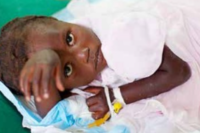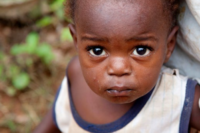 By Joseph Giere, MD
By Joseph Giere, MD
Cervical cancer is the most common cause of cancer deaths in the resource poor world. It is known as a disease of the poor. The recorded death rate in Haiti from cervical cancer is the highest one in the world. Haiti records more deaths in women ages 15 to 44 from cervical cancer than from any other reason. The most reliable figure for incidence of cervical cancer is 94/100,000. This is 50 times that of the United States. Deaths caused by cervical cancer in Haiti are 4 times higher than in Dominican Republic which shares the island of Hispaniola with the Republic of Haiti. Not only is the death rate higher, but Haitian women develop cervical cancer at a younger age and die younger than in the rest of the world.
Cervical cancer is recognized as a preventable and in early stages as a curable disease. Sexually transmitted human papilloma virus (HPV) has been identified as the initiator of cervical cancer. Vaccines can prevent viral diseases. Vaccines to counter cervical cancer exist and are effective. In low resource countries costs of vaccines can be as low as a Starbuck’s coffee and bagel.
Cells in younger women are most vulnerable to viral damage. In Haiti the median age for first sexual encounter is age 18. This may make the problem even more deadly if we recall that the median age 18 represents the age at which half the group have already begun sexual intercourse. One hundred human papilloma viruses (HPV) have been identified. Testing is available to identify the fourteen “Hi risk” viruses which are casually linked to cervical cancer. Two particularly virulent papilloma viruses, numbers 16 and 18, are found to account for two thirds of the world’s cervical cancers. These two viruses are present in higher numbers in Haitian women in country than in immigrant Haitian women living in Little Haiti Miami. HPV 16 and 18 prevalence has twice the reported prevalence in Haiti compared to reports in similar neighboring western hemisphere countries (Mexico, Argentina, Costa Rico, Colombia, Chile, Peru, and Brazil).
Other reasons offered for the high death rate in low resource countries are the lack of screening resources and funding. The Haitian Ministry of Health has made cervical cancer prevention a priority. They say, in Kreyòl, the mother is the ‘poto mitan’ of the family; she is the center pole that holds the entire family up. Haitian families can’t afford to lose their ‘poto mitan’— these young women. That’s why we need to prevent cervical cancer.
 Although the government of Haiti has recognized the need for cervical cancer screening programs, at present there is no coordinated nationwide screening program, no cervical cancer registry, or major treatment sites In Haiti. NGOs (non government organizations) try to fill this vacuum. The absence of coordinated programs to recognize early cancer compounds the problem. Delayed recognition, when symptoms are absent, leads to delay of effective early non surgical treatment. Advanced cancer bleeding stages can take 10 years to develop. By these late stages, the more costly less successful therapies for advanced cervical cancer lesions may necessitate travel to Santa Domingo, Cuba or Miami. Prevention and recognition of early precancerous lesions are proven to save money.
Although the government of Haiti has recognized the need for cervical cancer screening programs, at present there is no coordinated nationwide screening program, no cervical cancer registry, or major treatment sites In Haiti. NGOs (non government organizations) try to fill this vacuum. The absence of coordinated programs to recognize early cancer compounds the problem. Delayed recognition, when symptoms are absent, leads to delay of effective early non surgical treatment. Advanced cancer bleeding stages can take 10 years to develop. By these late stages, the more costly less successful therapies for advanced cervical cancer lesions may necessitate travel to Santa Domingo, Cuba or Miami. Prevention and recognition of early precancerous lesions are proven to save money.
Over the past 10 years, Dr. David Walner, a gynecologist from Duke University, collected almost 12,000 liquid pap smears* in the town of Leogane in southern Haiti. His report, released in spring 2013, is the first major piece of accurate data on cervical cancer in Haiti. Dr. Walner’s work confirmed that biopsies of cancer or the pre cancers positive for the high risk HPV 16 and 18 viruses could successfully receive treatment in his clinics.
Testing for the high risk HPV group of viruses is expensive; costing about $150 dollars in the U.S. Biopsies cost significantly more. There are no more than nine trained pathologists in all Haiti who are available to read biopsies. By contrast, New York City has about 570 pathologists. This is why the treatment currently in use in low resource countries is “One Visit; See and Treat.“ Pap testing is not done. Ordinary vinegar (3% acetic acid) is applied to the cervix. Vinegar identifies rapidly multiplying cervical cells and produces white patches on the cervix. In some instances these lesions can be forerunners of cancer. Probes can be applied directly to the cervix (cryotherapy) to destroy these spots by freezing. “One Visit; See and Treat” is seen as workable in low resource countries. Without a biopsy to prove that a true malignancy is present, the method means many benign cervical conditions are over treated. In place of a fly swatter, the pesky house fly is being eradicated with a baseball bat.
The best estimate is that less than 5% of Haitian women have ever had a pap smear.
Although there is a not yet a formal screening and treatment referral program in Milot, patients can purchase a kit from the pharmacy for the equivalent of $15.00 (Haitian average daily wage is $3). The smear is sent to Port-Au-Prince for interpretation by a volunteer. Results can be made available in Milot in about 4 weeks. Follow up biopsies and treatment can be problematic. Hôpital Sacré Coeur Gyn surgeon volunteer help by returning to the U.S. with pap smears. In one recent week we were able to collect 300 pap smears through an informal word of mouth advertising network. It required up to 4 months for final results to be completed by a U.S. volunteer pathologist.
 What results when women and their health providers lack cancer awareness? Tufts University Public Health students conducted a short survey of 61 women in Milot. They wanted to gauge how to prepare a successful screening program within the town culture of Milot. Women were asked if they knew of cervical cancer in Milot. Everyone (100%) had heard of cervical cancer. Most (55.7%) knew of someone who had had cervical cancer (They also were aware that the majority died i.e. cervical cancer was not always curable). Some women (37%) knew that cervical cancer was preventable and a majority (72.1%) had heard of test to screen for cervical cancer.
What results when women and their health providers lack cancer awareness? Tufts University Public Health students conducted a short survey of 61 women in Milot. They wanted to gauge how to prepare a successful screening program within the town culture of Milot. Women were asked if they knew of cervical cancer in Milot. Everyone (100%) had heard of cervical cancer. Most (55.7%) knew of someone who had had cervical cancer (They also were aware that the majority died i.e. cervical cancer was not always curable). Some women (37%) knew that cervical cancer was preventable and a majority (72.1%) had heard of test to screen for cervical cancer.
The women were asked what they knew of the causes. They were able to correctly identify intercourse 73.3%, virus 35%, and early sexual debut 4.9%. Other answers given but incorrect included family history 36.7%, another person causes it 36.7%, old age 30%, poor nutrition 23%, interpersonal violence 23%, bad Spirits (a voodoo curse)16%, sexual position 13.1% and bad luck 8.3%.
This showed there was a demonstrable need for better public information in Milot!
The majority of women agreed they would be more likely to use the test if It would be easier and if the test was less expensive. Other reasons included: if there was family support 37.3%, a closer defined location (35.5%), easier transportation (28.8%), more comfort with the doctor (16.9%), if they had symptoms occurring (16.9%), and they did not have to work (6.8%).
What can we learn from this?
One conclusion from this limited study is we needed to make our community aware that death from cervical cancer is preventable.
Some participants agreed they would find money for the test if it were available at a set time, set place and with testing schedule. This would be our task. Most maintained that the cost was too prohibitive and that from what they knew about cervical cancer and testing they would not seek testing. Accurate public information is part of our task.
What other possible information do we have on hand to learn about cervical cancer in Milot, Haiti?
We had on hand a liquid pap study on 250 women in Milot done in 2012 by Tufts Public Health trainees. They reported 13% abnormal pap smears in Milot. Our recent final total of 345 basic glass pap smears read by the volunteer pathologist here in Maryland show 58 (16.7%) “not normals” which needed more definitive follow up testing. We have to surmise from these limited numbers that the Milot yield of abnormal pap results could be three times the 5% yield found in most U.S. studies.
At Hôpital Sacré Coeur our solution is being rolled out. An expert pathologist, with 14 years experience, Dr. Rene Santos has joined the medical staff. He has been working since early March 2015 to train three of the current lab staff to become cytopathologists skilled in interpreting glass pap smears. Dr. Santos estimates their training will take 6 months. Laboratory space has been built for Dr. Santos. Lab machines to process biopsy tissues are in being assembled.
The HSC pathology lab will be the only medical lab able to offer this advanced service to all area medical facilities serving the over 4 million population in Northern Haiti.
Pap smear charges will be decreased. Public information disbursement through community leaders, local churches and radio is planned. The intention is to build a quality screening and early treatment program in Milot as a model for Haitian medical care.
Haiti is a land of earthquake and hurricanes. Earthquakes and hurricanes cannot be prevented. The campaigns to eliminate Polio and Smallpox prove viruses can be eradicated. Haiti need not be the land of cervical cancer IF cervical cancer can be prevented.
*In liquid pap smears collection cells are placed in a vial with a preservative medium. Cells are read by a computer and if read abnormal reflex testing for hi risk HPV occurs using the original liquid. Glass pap smear testing involves plating the cells on a slide with fixative and a dye before evaluation. This older method does not allow for reflex testing.
Dr. Joseph Giere is a Washington, D.C. based obstetrician-gynecologist who has volunteered in Milot for over a decade. Dr. Giere also serves on The CRUDEM Foundation Board of Directors.
Useful Medical Terms
Incidence
Incidence is a measure of disease that allows us to determine a person’s probability of being diagnosed with a disease during a given period of time. Therefore, incidence is the number of newly diagnosed cases of a disease. An incidence rate is the number of new cases of a disease divided by the number of persons at risk for the disease. If, over the course of one year, five women are diagnosed with breast cancer, out of a total female study population of 200 (who do not have breast cancer at the beginning of the study period), then we would say the incidence of breast cancer in this population was 0.025 (or 2,500 per 100,000 women-years of study).
Prevalence
Prevalence is a measure of disease that allows us to determine a person’s likelihood of having a disease. Therefore, the number of prevalent cases is the total number of cases of disease existing in a population.
A prevalence rate is the total number of cases of a disease existing in a population divided by the total population. So, if a measurement of cancer is taken in a population of 40,000 people and 1,200 were recently diagnosed with cancer and 3,500 are living with cancer, then the prevalence of cancer is 0.118.(or 11,750 per 100,000 persons).
Morbidity
Morbidity is another term for illness. A person can have several co-illnesses simultaneously. So, morbidities can range from TB, malnutrition, to cancer to hypertension. Morbidities are NOT deaths. Prevalence is a measure often used to determine the level of morbidity in a population.
Mortality
Mortality is another term for death. A mortality rate is the number of deaths due to a disease divided by the total population.
Suggested Resources Available:
Haiti – ICO Information Centre on HPV and Cancer Updated December 13, 2014
www.hpvcentre.net/statistics/reports/HTI_FS.pdf
I. Key data on HPV and HPV-related cancers. Haiti has a population of 3.45 million women ages 15 years and older who are at risk of developing cervical cancer.









